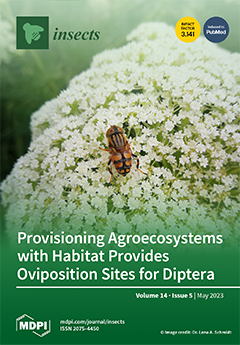MiRNAs, as a kind of key regulators in gene expression, play vital roles in numerous life activities from cellular proliferation and differentiation to development and immunity. However, little is known about the regulatory manner of miRNAs in the development of Asian honey bee
[...] Read more.
MiRNAs, as a kind of key regulators in gene expression, play vital roles in numerous life activities from cellular proliferation and differentiation to development and immunity. However, little is known about the regulatory manner of miRNAs in the development of Asian honey bee (
Apis cerana) guts. Here, on basis of our previously gained high-quality transcriptome data, transcriptome-wide identification of miRNAs in the larval guts of
Apis cerana cerana was conducted, followed by investigation of the miRNAs’ differential expression profile during the gut development. In addition to the regulatory network, the potential function of differentially expressed miRNAs (DEmiRNAs) was further analyzed. In total, 330, 351, and 321 miRNAs were identified in the 4-, 5-, and 6-day-old larval guts, respectively; among these, 257 miRNAs were shared, while 38, 51, and 36 ones were specifically expressed. Sequences of six miRNAs were confirmed by stem-loop RT-PCR and Sanger sequencing. Additionally, in the “Ac4 vs. Ac5” comparison group, there were seven up-regulated and eight down-regulated miRNAs; these DEmiRNAs could target 5041 mRNAs, involving a series of GO terms and KEGG pathways associated with growth and development, such as cellular process, cell part, Wnt, and Hippo. Comparatively, four up-regulated and six down-regulated miRNAs detected in the “Ac5 vs. Ac6” comparison group and the targets were associated with diverse development-related terms and pathways, including cell, organelle, Notch and Wnt. Intriguingly, it was noticed that miR-6001-y presented a continuous up-regulation trend across the developmental process of larval guts, implying that miR-6001-y may be a potential essential modulator in the development process of larval guts. Further investigation indicated that 43 targets in the “Ac4 vs. Ac5” comparison group and 31 targets in the “Ac5 vs. Ac6” comparison group were engaged in several crucial development-associated signaling pathways such as Wnt, Hippo, and Notch. Ultimately, the expression trends of five randomly selected DEmiRNAs were verified using RT-qPCR. These results demonstrated that dynamic expression and structural alteration of miRNAs were accompanied by the development of
A. c. cerana larval guts, and DEmiRNAs were likely to participate in the modulation of growth as well as development of larval guts by affecting several critical pathways via regulation of the expression of target genes. Our data offer a basis for elucidating the developmental mechanism underlying Asian honey bee larval guts.
Full article






